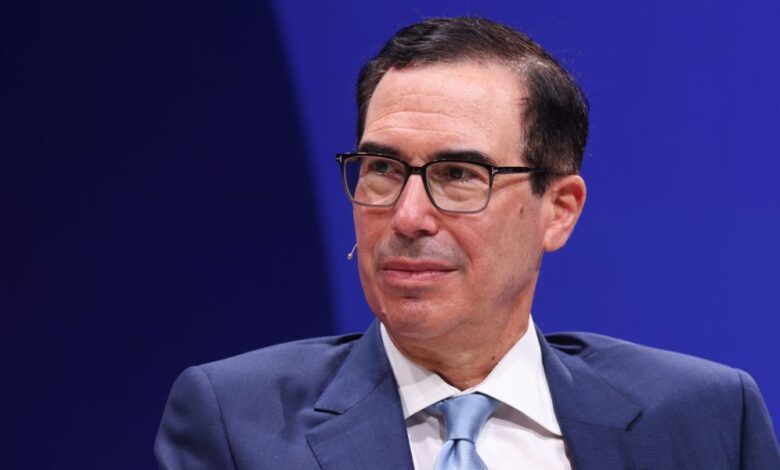Steve Mnuchin calls for phasing out the 20-year Treasury note he reintroduced


A quick glance at the U.S. bond curve tells you something is wrong. One Treasury security—the 20-year bond—is standing apart from the rest of the market. It’s trading at a much higher yield than the bonds around it—the 10-year and 30-year bonds.
This isn’t just a cosmetic concern for traders. It’s costing U.S. taxpayers money. Since the Treasury Department reintroduced 20-year bonds in monthly auctions four years ago, selling them has added about $2 billion a year in interest costs on top of what the government would otherwise pay, a simple calculation shows. That’s about $40 billion over the life of the bonds.
To some extent, this is a small amount for a government that spends almost 7 trillion dollars annually. However, $2 billion is a long way off. It’s the same amount government spending annually to operate the national park system and more than the amount of home-buying assistance for veterans.
Ask most bond market experts this question and they’ll be hesitant to say whether the 20-year bond should be eliminated to save money. They say it’s more complicated than it seems. But one person—out of about a dozen interviewed for this story—stated without hesitation or qualification that it should be eliminated. That person, to put it bluntly, is the man who brought the bond back to life in 2020: Steven Mnuchin.
“I’m not going to continue issuing them,” Mnuchin, who served as Treasury secretary under President Donald Trump, said when contacted by Bloomberg News. The conceit—creating another maturity to help lock in decades of low borrowing costs—made sense at the time, he said, but things simply didn’t work out as planned. “It’s just expensive for taxpayers.”
Mnuchin’s change of heart in some ways resembles the “move fast and break things” approach to policymaking that Trump and his team favor. The Biden administration, by contrast, is taking a more conventional approach and sticking with 20-year bonds—albeit on a smaller scale—to ensure continuity and stability in the government’s debt-selling program. (A Treasury spokesperson declined to comment.)
Regardless of which party wins the White House in November, the takeaway from the 20-year bond rollout is clear: Managing the government’s growing deficit is becoming increasingly difficult. Almost 2 trillion dollarsdouble the level of five years ago. And investors won’t necessarily be eager to buy some new bonds just because the Treasury puts them in front of them.
This is simply the grim new reality of U.S. finances, bond market experts say. The country needs as many creditors willing to lend money as possible. And for those who are hesitant to recommend a quick end to 20-year bond auctions, that need is paramount — even if it means paying to attract buyers to a new type of security on the market.
“Having another point of maturity gives them some more flexibility,” said Brian Sack, head of macro strategy at multi-strategy hedge fund Balyasny Asset Management.
America continue to sell 20-year bond in May 2020 after more than three decades of hiatus.
There were early signs that the debt would be costly. Bond market advisers who approved the new maturity date warned the Treasury not to overestimate demand. However, the initial auction size was significantly larger than recommended.
“We wanted to issue as much long-term debt as possible to extend the maturity and lock in the very low interest rates that were available at the time,” said Mnuchin, who now runs the private equity firm Liberty Strategic Capital. He even wanted to introduce ultra-long-term debt—securities that mature in 50 or 100 years—but settled on 20 years when advisers discouraged the idea.
The 20-year bond really started to fall in price after a series of auction size increases and quickly became the highest-yielding U.S. government security. Today, even after auctions have declined, it remains the most expensive form of financing other than short-term T-bills.
Analysts point to several reasons why the 20-year bond keep fighting. Notable among them are: it is not as liquid as the 10-year and has a lower maturity or interest rate risk than the 30-year.
At 4.34%, the 20-year yield is currently 0.23 percentage points higher than the average of 10-year and 30-year bonds. It can be difficult to measure the cost of replacement financing precisely because 10-year and 30-year yields could be slightly higher today if the Treasury had sold more bonds instead of issuing 20-year bonds. But that yield gap, when calculated at the time of issuance over the past four years, amounts to an estimated $2 billion in additional costs per year.
A more conservative calculation of the additional cost, based on the gap between Treasury yields and interest rate swaps, puts the figure at about half that amount.
“From the taxpayer’s perspective, the most important thing is, over time, can you reduce the cost of borrowing?” said Ed Al-Hussainy, an interest rate strategist at Columbia Threadneedle Investments in New York. “It’s not clear we’ve done that.”
Al-Hussainy was one of the few in the market who shared Mnuchin’s view. He said the whole thing was a “mistake.” “There’s not a lot of demand for these particular bonds. It doesn’t make sense.”
In an effort to better balance supply and demand, the Treasury has significantly cut back on issuance of maturing bonds in recent years. Quarterly sales of 20-year bonds are now at $42 billion, down from a peak of $75 billion.
“The Treasury has taken the 20-year bond to a more appropriate size,” said Sack, who serves on the Treasury’s Debt Advisory Committee, a group of bond brokers and investors that advises the government on issuance strategy. In 2020, the committee supported the launch of a 20-year bond. “That market is more balanced than it was a few years ago.”
And Amar Reganti, former deputy director of the Treasury Department’s Office of Debt Management, said the market could look better in a few years. Reganti stressed that it could take time for the new securities to attract the same steady demand as other maturities.
While four years since launch may seem “a long time in equity markets,” “it’s actually a pretty short time from a debt management perspective,” said Reganti, now a fixed income strategist at Hartford Funds.
Not with Mnuchin. He said the market has had enough time to make a judgment.
Meanwhile, one group has stopped selling 20-year bonds: American companies. At first, CFOs across the country enhanced selling 20-year bonds when the Treasury Department reintroduces the term, which is one of the positive effects that policymakers are looking for.
But that recovery quickly faded, and today the market is all but dead. New offerings totaled just $3 billion in the first half of the year, down from $82 billion for all of 2020. The maturity represented less than 1% of total sales of 10-year and 30-year bonds, down from about 10% previously, according to data compiled by Bloomberg.
“We’ve always said that in the corporate market, supply follows demand and there’s not a lot of demand for 20-year bonds overall,” said Winnie Cisar, head of global credit strategy at CreditSights. “It’s just a weird maturity.”




